This is the story of the first church to be built in the village, which served the community until the late 20th Century. In the 21st Century it was saved from destruction by conversion into flats, but the grand facade still looks down on Pollokshaws Road. The article is based largely on the account of a former minister, Rev John M Munro, who wrote his history of the church and the village on the occasion of the congregation’s 100th anniversary in 1933. The book is reproduced in its entirety here, for those who wish to study it further . I’m grateful to Morris Scott of St Andrews, who acquired the book by accident in his work as a removals man. He sought me out and donated it.
In the early part of the 19th Century Strathbungo was a poor and somewhat remote village of miners and weavers in the south east of Govan Parish, with a long trek to Govan Parish Church for the Sunday service. There was already a second church in the parish established in the Gorbals, and in 1833 Dr Leishman, the new minister of Govan, established a mission in the village of Strathbungo. They probably met in the school house initially, and efforts were begun to raise money for a church.
The first church
The General Assembly gave permission for the new church in 1838, and with the money raised, land was purchased from Hutcheson’s Hospital immediately to the north of the village. The new church was built 1839-40 to a design by Charles Wilson, for the sum of £1300.
Rev. Alexander Sutherland, was appointed Strathbungo’s first minister in 1848, having previously been the missionary at Strathbungo.
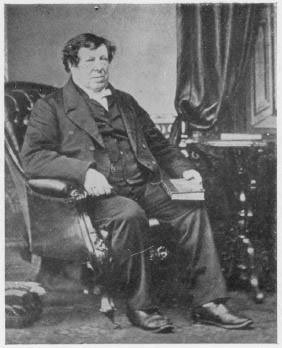
Rev Alex Sutherland, 1848-75
The small bell tower was possibly a later addition, and a new church bell was acquired in 1849-50, inscribed “David Burges, Founder, Glasgow, 1849”. It was preserved after demolition, and kept in the session house of the later church, although its later fate in unknown. Burges was the manager of the Gorbals Brass and Bell Foundry, which existed from 1838 to 1928 .
Although not a full member of the congregation, Neale Thomson of Camphill House furnished the first manse around 1852-4. The manse stood amongst trees in Allison Street (the former Arnold Clark site), and was known as Boyd’s Cottage. There was an old story of a parishioner who fled to the cottage for comfort one night in the mirk, having seen the dead of the Battle of Langside rise up in procession along the avenue from Camphill House, as she stood at the park gates by the pond. The area of marshy land around the pond and towards the bandstand was thought to be where the dead of the battle were buried, and was known as the Devil’s Kirkyard.
In February 1856 a great storm struck Glasgow, causing immense damage over a wide area. The Stirling Observer reported that
The steeple was prostrated, tearing an immense aperture in the roof, and fell into the area of the church, where it made terrible havoc among the woodwork. Three large chimney-stalks on Mr Thomson’s bread factory at Crossmyloof fell. Camphill, Campvale, Darnley Terrace, and the whole of the villas in that quarter, suffered to a great extent.
The book notes how £137 was raised to pay for the damage caused to the church by the storm.
Later Thomson provided a cottage on Langside Avenue for the use of the minister at his own cost, but died soon after. He had forgotten to include it in his will, and the minister had to move again, to 220 Langside Road, on the corner of Allison Street.
The early schools in Strathbungo are described elsewhere, but in 1840 the Govan sessional school opened in Nithsdale Street, where March St is now, and the school remained there probably until 1873, when responsibility for schooling passed from the church to the new School Boards.
Robert Burns’ last surviving daughter worshipped at the church.
After 20 years or so in post, Rev Sutherland was ageing and lacking the vigour of his youth, but declined to step aside, so much of the congregation joined those of Crosshill to set up a new church in 1868 in a temporary structure opposite the park, and by 1873 had erected a new church at 40 Queens Drive. Rev Sutherland died in November 1875 at the age of 81.
Rev Alexander Clark from Ayrshire, the University of Glasgow, and India, returned as assistant, and was appointed as minister in December 1875, and took over in January 1876, only to accept a post in Wick in February; which must have been one of the shortest terms ever.
Rev Robert McMillan, also of Ayrshire, and the University of Glasgow, took over in July 1876. There were only 60 left in the congregation at that time. However from September to December 1876, growth led to the addition of a gallery to increase seating by 300. During construction, the congregation were loaned the use of the temporary church that had been erected behind Bute Terrace (now the junction of Niddrie Road and Torrisdale Street) by the Queens Park Free Church congregation while their own new church was built at Queens Drive at Albert Drive – the latter opened in 1875 and is now Queens Park Church of Scotland. The temporary church, built of brick, probably with a corrugated iron roof, was known as the “iron church”. A harmonium was introduced in the temporary church – the first musical accompaniment ever used by the congregation. The site of the iron church was approximately where Langside Synagogue sits now. Although the buildings are similar in size and form, the synagogue is a 20th century building.
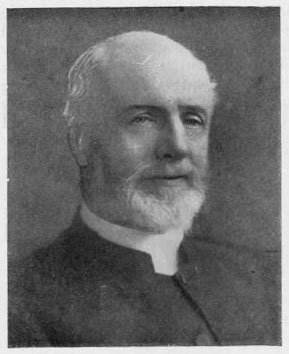
Rev Robert McMillan, 1876-1916
The formation of Strathbungo Parish
The congregation set about establishing themselves as a parish in their own right around 1875, but first needed to sort out the boundaries, a recurring theme of Strathbungo history. Regents Park (modern Strathbungo) had been allocated to Queens Park Church in March 1875, but even then the residential area was universally known as Strathbungo, and residents attended Strathbungo Church, so it was given back to Strathbungo. Strathbungo Parish Church came into being on 13 January 1879. The new parish extended from Eglinton Toll to old Haggs Road (now Titwood Road) and Crossmyloof. The parish was estimated to have a population of 2500.
Plans were soon made for a better church, but the failure of the City of Glasgow Bank in October 1878 put paid to that for several years, as the bank held their funds.
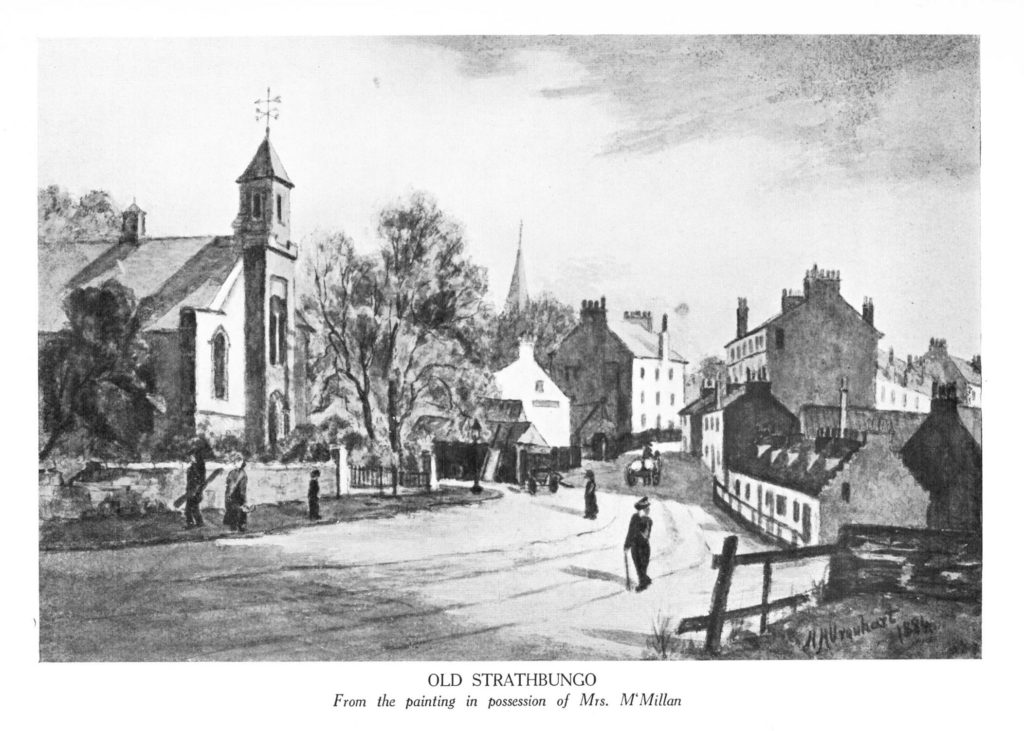
Old Strathbungo, c 1884, showing the old church on the left, in its final years.
The second church
By 1883, finances were improving again, and plans were again made to replace the church, apparently with J Ritchie winning a design competition, but with the design by Mr John McKissack (of McKissak & Rowan) being accepted . McKissack was a member of the congregation. Services were to be held in the Drill Hall on Coplaw St (which had just been constructed) during the disruption. The new church would hold 1000 or more people, and cost some £6000.
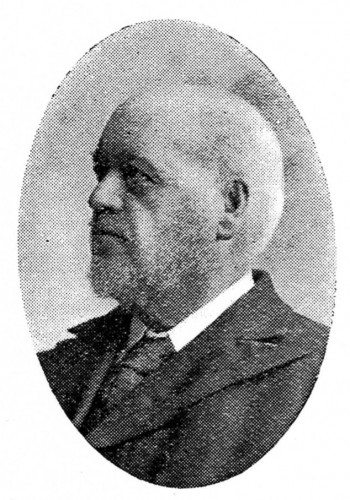
John McKissack
Extra ground purchased from Hutchesons’ Hospital allowed for a larger church and a hall besides. The hall was completed in October 1887, and construction of the church began.
Earl Hopetoun, Lord High Commissioner to the General Assembly of the Church of Scotland, was invited to perform the laying of the memorial stone on 22nd October, but he was unable to attend due to his wife’s illness – she had just given birth. Sir John Neilson Cuthbertson, chair of Glasgow School Board, stepped in to take his place. This resulted in the ceremonial trowel created to celebrate the Earl’s contribution going unused. It re-emerged in 2023 in the hands of a Massachusetts collector, though how it reached the USA is unclear.
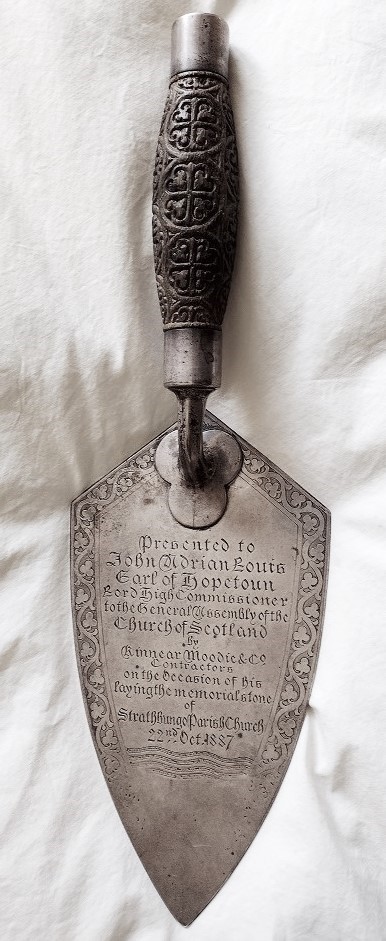
Ceremonial silver trowel by T Smith & Son of Glasgow. It celebrates Earl Hopetoun’s laying of the memorial stone, but he wasn’t there. The trowel also identifies the contractor, Kinnear Moodie & Co of Edinburgh. Credit: Dennis Knight
Sir John laid the foundation or memorial stone of the new church in the northern angle of the great tower 20 feet from the ground. A time capsule was placed beneath it containing local newspapers, a brief church history, and, to mark Queen Victoria’s Jubilee that year, a set of silver jubilee coins.
The 1879 iron railings from the old church were retained but moved back when the road was widened. The bell and three windows of the old church were preserved, and much of the stone reused in the new building. The church opened on 7th October 1888. The building’s Category B listing describes it thus: “Combines Romanesque and Scots Gothic elements. Snecked and stugged ashlar, polished dressings, slate roofs. Lofty gabled front to street with massive stepped buttresses, sculptured doorway, square tower to left also with stepped buttresses, walls almost blank to belfry stage, open crown spire springing from domed finials and surmounted by little lantern. Church Hall to rear (E) incorporates work by Wilson.” McKissack also designed the romanesque Queens Park Baptist Church at 178 Queens Drive in the same year.
A small hall was added in the NE corner of the site in 1898 at a cost of £500.
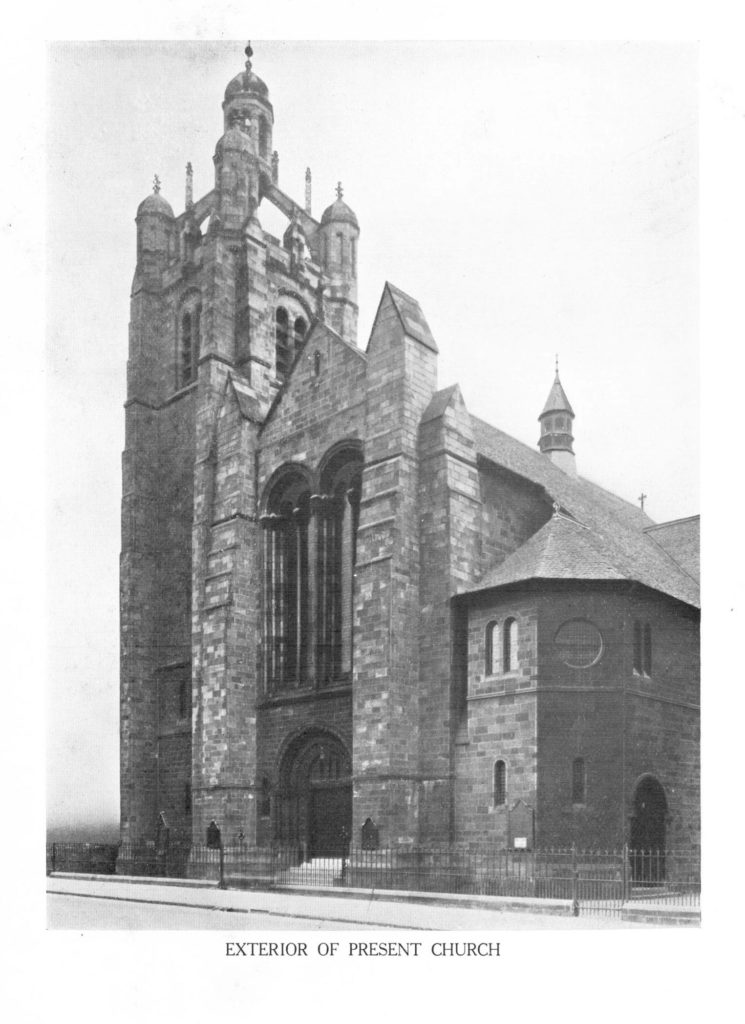
Strathbungo Parish Church c 1930
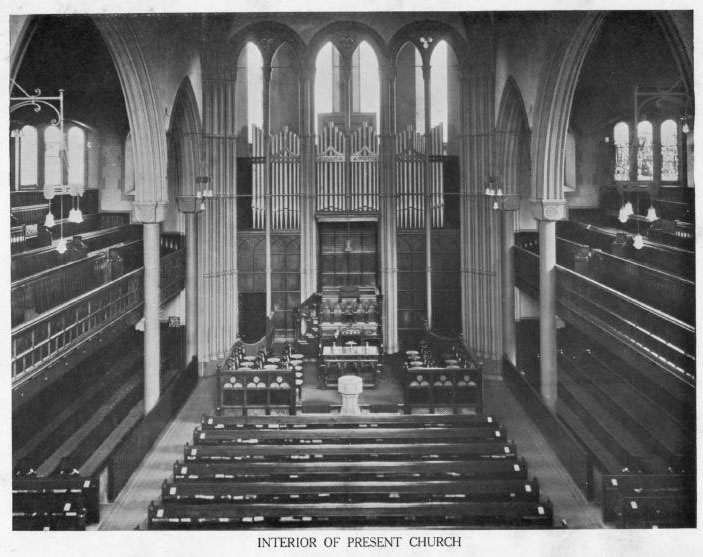
Church Interior
Some 300 of the congregation, men and women, answered the call of duty in the Great War of 1914-18, and 49 of them gave their lives and are listed on the church’s memorial plaque and roll of honour (which I believe still exists, having been moved to Queens Park Church).
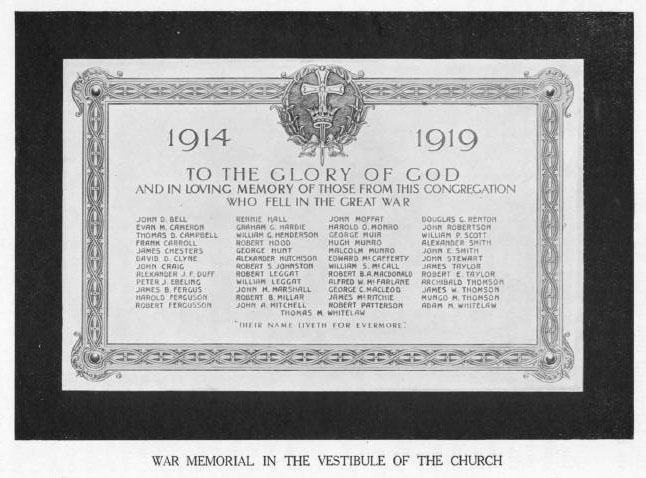
Roll of Honour, The Great War
Rev McMillan retired in November 1916 at the age of 70, and Rev Charles Guthrie Cooper was chosen as his successor in April 1917. He left for Hawick in 1926, but during his time increased the congregation above 1000 for the first time, and on to 1500.
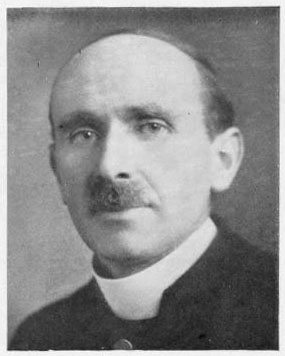
Rev C Guthrie Cooper, 1917-1926
Rev John M Munro, from Oban, took over in November 1926, and compiled this history of the church and congregation on its 100 year anniversary in 1933.

Rev John M Munro

Kirk Session & Board c 1933
The latter years, dereliction and resurrection
I have few details of the church after John Munro’s account. Hugh Martin was the minister in the 1960s. The church closed to worship in May 1979, and was sold on, but gradually became derelict. After a compulsory purchase order by Glasgow City Council, the body of the church was demolished, but the tower and facade retained, along with an arch from the church hall. The Southside Housing Association constructed new flats behind the facade in 2006, providing 28 new homes, including 11 for residents with sensory deprivation .
And presumably that treasure chest is still there…

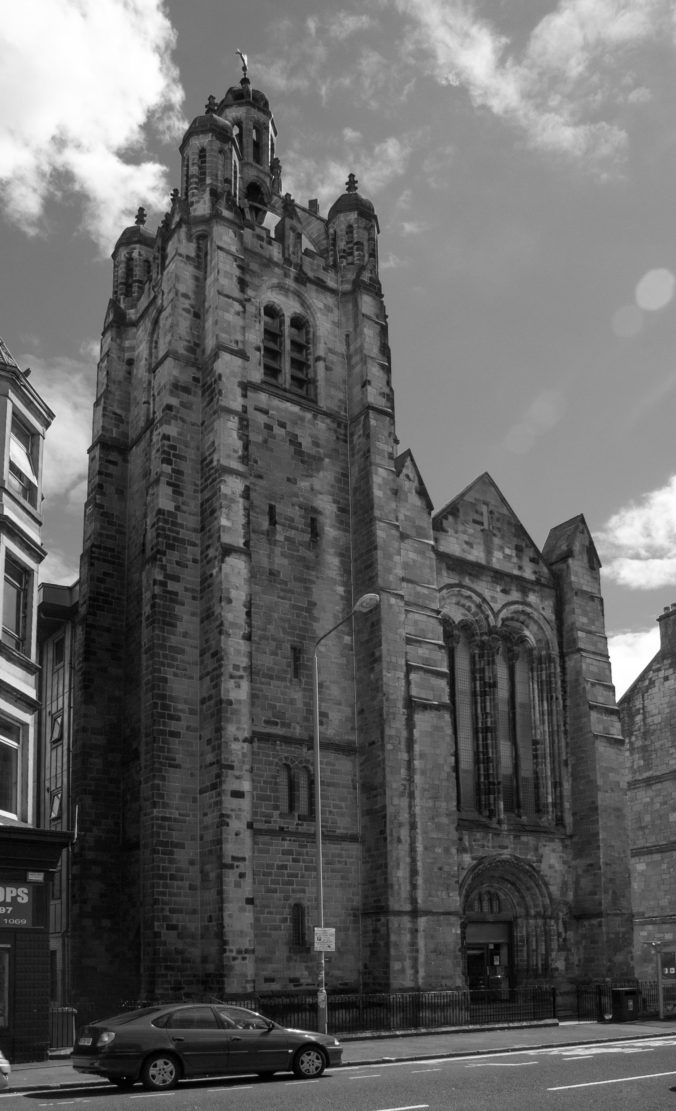
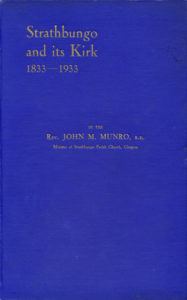

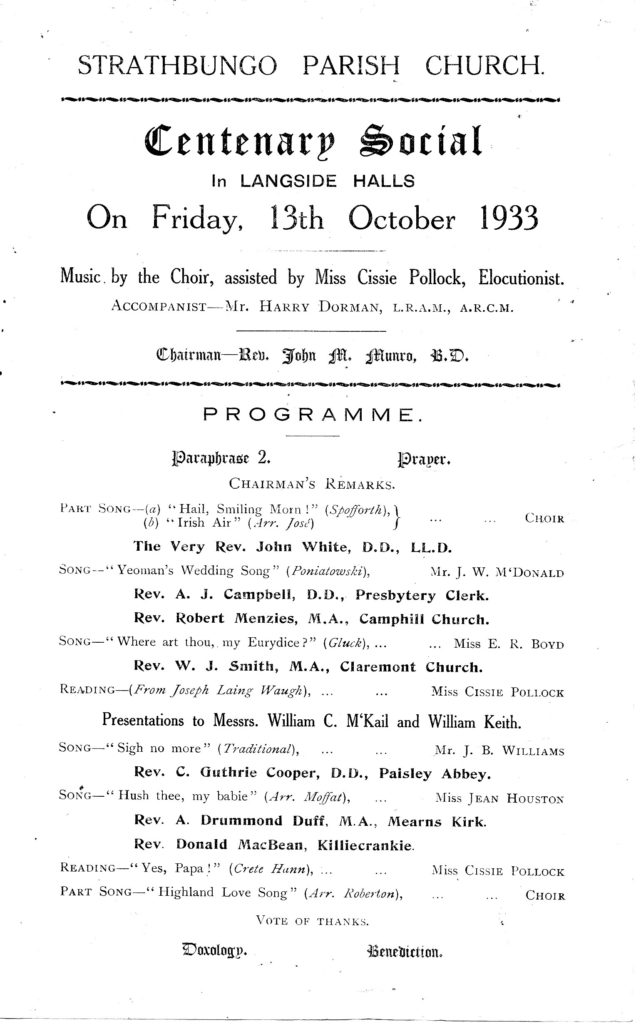
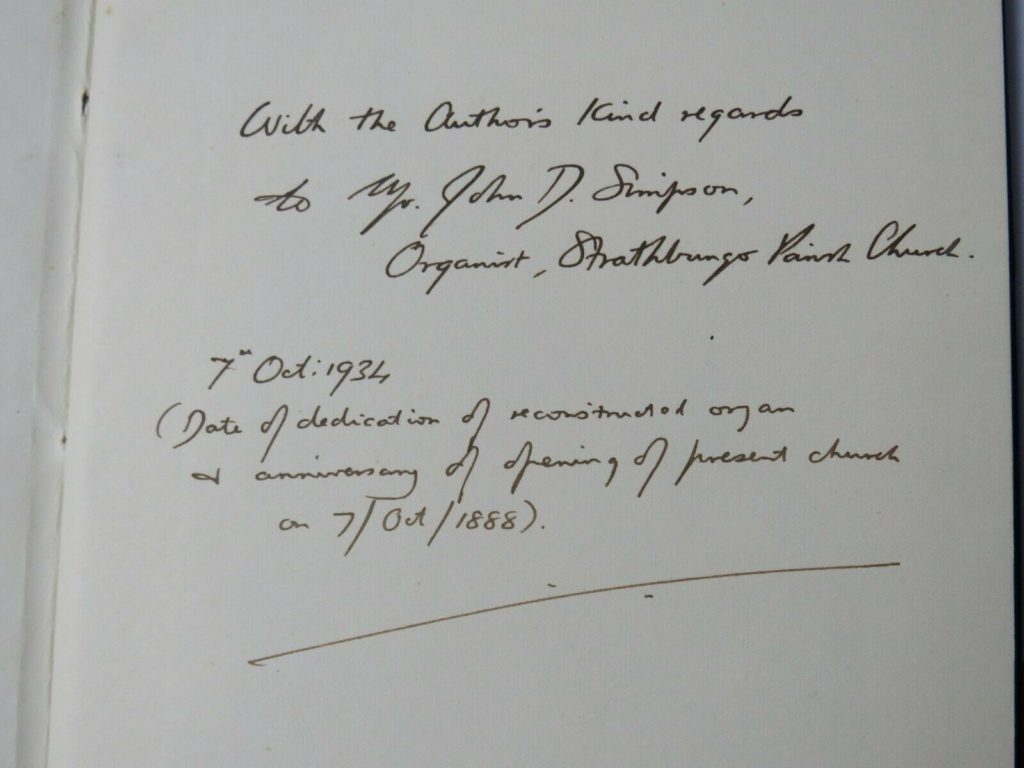
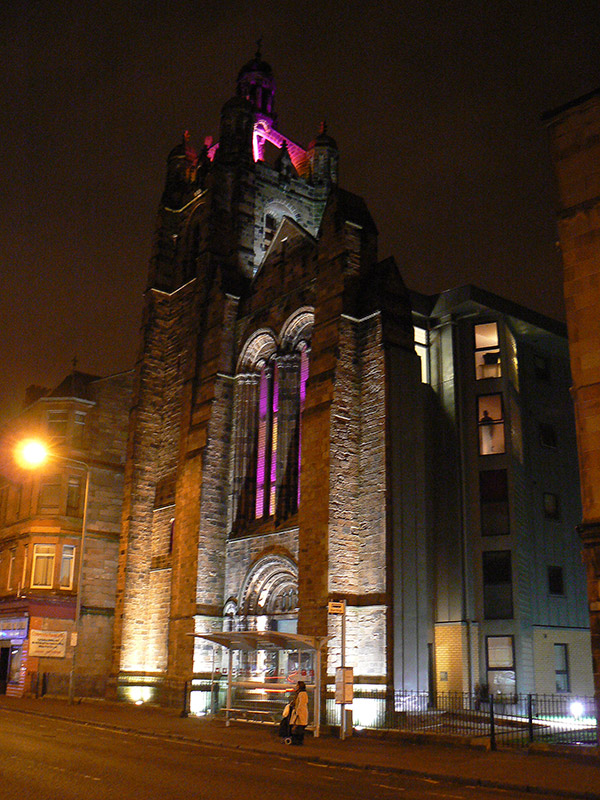
Leave a Reply